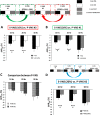Stochastic vagus nerve stimulation affects acute heart rate dynamics in rats
- PMID: 29590213
- PMCID: PMC5874066
- DOI: 10.1371/journal.pone.0194910
Stochastic vagus nerve stimulation affects acute heart rate dynamics in rats
Abstract
Vagus nerve stimulation (VNS) is an approved therapy for treatment of epilepsy and depression. While also shown to be promising in several preclinical and clinical studies to treat cardiovascular diseases, optimal therapeutic stimulation paradigms are still under investigation. Traditionally, parameters such as frequency, current, and duty cycle are used to adjust the efficacy of VNS therapy. This study explored the effect of novel stochastic VNS (S-VNS) on acute heart rate (HR) dynamics. The effect of S-VNS was evaluated in Sprague Dawley rats by comparing the acute HR and HR variability (HRV) responses to standard, periodic VNS (P-VNS) across different frequencies (FREQs, 10-30 Hz). Our results demonstrate that both S-VNS and P-VNS produced negative chronotropic effects in a FREQ-dependent manner with S-VNS inducing a significantly smaller drop in HR at 10 Hz and 20 Hz compared to P-VNS (p<0.05). S-VNS demonstrated a FREQ-dependent drop in the SD1/SD2 ratio, a measure of HRV, which was absent in P-VNS, suggesting that S-VNS may acutely modulate the nonlinear relationship between short- and long-term HRV. In conclusion, S-VNS is a novel stimulation procedure that may provide different physiological outcomes from standard P-VNS, as indicated by our analysis of HR dynamics. Our study provides a rationale for further detailed investigations into the therapeutic potential of S-VNS as a novel neuromodulation technique.
Conflict of interest statement
Figures






Similar articles
-
Optimal Vagus Nerve Stimulation Frequency for Suppression of Spike-and-Wave Seizures in Rats.Artif Organs. 2016 Jun;40(6):E120-7. doi: 10.1111/aor.12669. Epub 2015 Dec 29. Artif Organs. 2016. PMID: 26713661
-
Defining the neural fulcrum for chronic vagus nerve stimulation: implications for integrated cardiac control.J Physiol. 2017 Nov 15;595(22):6887-6903. doi: 10.1113/JP274678. Epub 2017 Sep 30. J Physiol. 2017. PMID: 28862330 Free PMC article.
-
Animal model of the short-term cardiorespiratory effects of intermittent vagus nerve stimulation.Auton Neurosci. 2008 Dec 5;143(1-2):20-6. doi: 10.1016/j.autneu.2008.07.002. Epub 2008 Aug 30. Auton Neurosci. 2008. PMID: 18757249
-
Vagus Nerve and Vagus Nerve Stimulation, a Comprehensive Review: Part III.Headache. 2016 Mar;56(3):479-90. doi: 10.1111/head.12649. Epub 2015 Sep 14. Headache. 2016. PMID: 26364805 Review.
-
Recent advances in devices for vagus nerve stimulation.Expert Rev Med Devices. 2018 Aug;15(8):527-539. doi: 10.1080/17434440.2018.1507732. Epub 2018 Aug 17. Expert Rev Med Devices. 2018. PMID: 30071175 Review.
Cited by
-
Effects on heart rate from direct current block of the stimulated rat vagus nerve.J Neural Eng. 2023 Jan 18;20(1):10.1088/1741-2552/acacc9. doi: 10.1088/1741-2552/acacc9. J Neural Eng. 2023. PMID: 36535037 Free PMC article.
-
Anodal block permits directional vagus nerve stimulation.Sci Rep. 2020 Jun 8;10(1):9221. doi: 10.1038/s41598-020-66332-y. Sci Rep. 2020. PMID: 32513973 Free PMC article.
-
Electric vagal nerve stimulation inhibits inflammation and improves early postoperation cognitive dysfunction in aged rats.BMC Anesthesiol. 2019 Nov 23;19(1):217. doi: 10.1186/s12871-019-0885-5. BMC Anesthesiol. 2019. PMID: 31759387 Free PMC article.
-
Advances in Cardiac Pacing: Arrhythmia Prediction, Prevention and Control Strategies.Front Physiol. 2021 Dec 2;12:783241. doi: 10.3389/fphys.2021.783241. eCollection 2021. Front Physiol. 2021. PMID: 34925071 Free PMC article. Review.
-
A Systematic Review and Meta-Analysis of Randomized Trials to Evaluate the Impact of Exercise on Heart Rate Variability Post-Bariatric Surgery.J Cardiovasc Dev Dis. 2024 Aug 13;11(8):248. doi: 10.3390/jcdd11080248. J Cardiovasc Dev Dis. 2024. PMID: 39195156 Free PMC article. Review.
References
-
- O’Reardon JP, Cristancho P, Peshek AD. Vagus Nerve Stimulation (VNS) and Treatment of Depression: To the Brainstem and Beyond. Psychiatry (Edgmont). Matrix Medical Communications; 2006;3: 54–63. Available: http://www.ncbi.nlm.nih.gov/pubmed/21103178 - PMC - PubMed
-
- Xie X, Lee SW, Johnson C, Ippolito J, KenKnight BH, Tolkacheva EG. Intermittent vagal nerve stimulation alters the electrophysiological properties of atrium in the myocardial infarction rat model. 2014 36th Annual International Conference of the IEEE Engineering in Medicine and Biology Society. IEEE; 2014. pp. 1575–1578. doi: 10.1109/EMBC.2014.6943904 - DOI - PubMed
-
- Lee SW, Li Q, Libbus I, Xie X, KenKnight BH, Garry MG, et al. Chronic cyclic vagus nerve stimulation has beneficial electrophysiological effects on healthy hearts in the absence of autonomic imbalance. Physiol Rep. 2016;4: e12786 doi: 10.14814/phy2.12786 - DOI - PMC - PubMed
-
- Annoni EM, Xie X, Lee SW, Libbus I, KenKnight BH, Osborn JW, et al. Intermittent electrical stimulation of the right cervical vagus nerve in salt-sensitive hypertensive rats: effects on blood pressure, arrhythmias, and ventricular electrophysiology. Physiol Rep. 2015;3 doi: 10.14814/phy2.12476 - DOI - PMC - PubMed
-
- Premchand RK, Sharma K, Mittal S, Monteiro R, Dixit S, Libbus I, et al. Extended Follow-Up of Patients with Heart Failure Receiving Autonomic Regulation Therapy in the ANTHEM-HF Study. J Card Fail. 2015; doi: 10.1016/j.cardfail.2015.11.002 - DOI - PubMed
Publication types
MeSH terms
Grants and funding
LinkOut - more resources
Full Text Sources
Other Literature Sources

